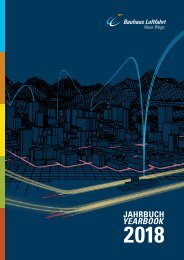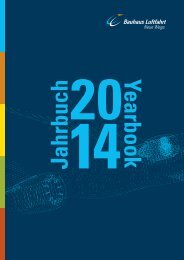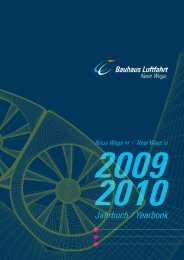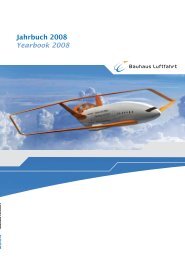Bauhaus Luftfahrt Jahrbuch 2019
- No tags were found...
Create successful ePaper yourself
Turn your PDF publications into a flip-book with our unique Google optimized e-Paper software.
19
Speicheroptionen für
Wasserstoff
Vergleich verschiedener Speicheroptionen
bezogen auf die Wasserstoffmenge und das
Tanksystemgewicht
Storage options for
hydrogen
Comparison of different storage options in
terms of hydrogen quantity and tank system
weight
Hydrogen-to-tank weight ratio
in kg-H 2 / kg-tank
10
1
0.1
0.01
Liquid hydrogen Non-vacuum isolated
Liquid hydrogen Vacuum isolated
Cryo-compressed hydrogen Vacuum isolated
Compressed gaseous hydrogen Type-4 pressure vessel
0 10 100 1000 10,000 100,000
Hydrogen weight in kg
Spezifische Emissionen
und Kosten erneuerbarer
Drop-in-Kraftstoffe
Die Produktion von LH 2 ist deutlich effizienter
und kostengünstiger als bei PtL-/StL-Kraftstoffen,
da kein CO 2 benötigt wird, Prozessschritte
entfallen und wenig Koppelprodukte
entstehen.
Specific emissions and
potential costs of
renewable drop-in fuels
The production of LH 2 is significantly more
efficient and cost-effective than for PtL/StL fuels,
since no CO 2 is required, process steps are
omitted, and few by-products are produced.
Specific GHG emissions in g-CO 2 -eq /MJ
100
90
80
70
60
50
40
30
20
10
0
329
Conventional jet fuel
HEFA / jatropha
BtL / eucalyptus
HEFA / microalgae
BtL / municipal solid waste
HEFA / used cooking oil
HEFA / yellow grease
BtL / poplar
HEFA / camelina
HTL /
PtL StL
forestry residues LH 2 BtL / forestry residues
0.4 0.6 0.8 1.0 1.2 1.4 1.6 1.8 2.0 2.2 2.4
BtL: Biomass to liquid
HEFA: Hydroprocessed esters and fatty acids
HTL: Hydrothermal liquefaction
Minimum fuel selling price * in EUR/L
[ * for LH 2 : per kerosene equivalent]
LH 2 :
PtL:
StL:
Liquid hydrogen
Power to liquid
Sunlight to liquid
8.43
Dr. Holger Kuhn Co-Lead Energy Technologies and Power Systems
Die Idee einer Wasserstoffwirtschaft ist älter als 150 Jahre, dennoch ist ihre Vorstellung sehr attraktiv und heutige
Technologiebausteine könnten die Vision einer deutlichen Emissionsreduzierung ermöglichen. Der Aufwand für den
Übergang zu einer Wasserstoffwirtschaft ist enorm, könnte sich aber in Zukunft durch die Etablierung eines nachhaltigen
Kreislaufes mithilfe erneuerbarer Energien auszahlen. Wasserstoff im Straßenverkehr ist von der Produktion bis zum Verbrauch
gut verstanden. Die Einführung von Wasserstoff in das Flugzeug ist eine anspruchsvolle Aufgabe. Mehrere Studien erörtern
die wichtigsten Designkriterien, bei denen das zusätzliche Volumen und neue Technologien gegenüber emissionsfreiem Betrieb
und Bodenprozessen abgewogen werden. Es ist eine Chance!
The idea of a hydrogen economy is older than 150 years, nevertheless its conception is still appealing and today’s
technology bricks could enable the vision of significant emissions reduction. The effort for a transition to a hydrogen
economy is enormous, but may pay off in the future by establishing a permanent cycle with the help of renewable sources.
Hydrogen as a fuel for ground transportation is well understood from production to consumption. Introducing hydrogen into the
aircraft is a challenging task. Several studies discuss the key design criteria balancing the extra volume and new technologies
against the emissions-free operation and ground procedures. It is a chance!














